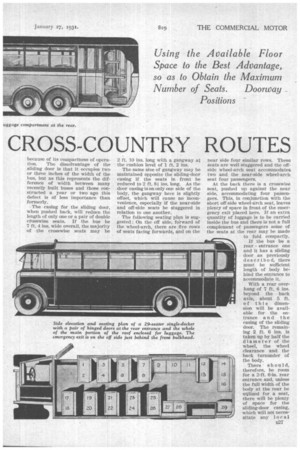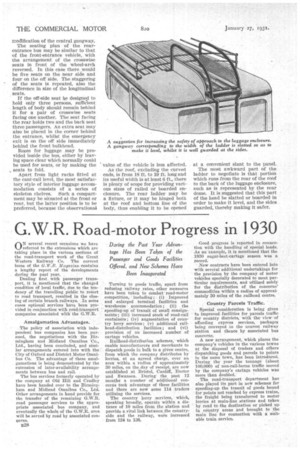SINGLE-DECKERS FOR CROSS-COUNTRY ROUTES
Page 44

Page 45

Page 46

If you've noticed an error in this article please click here to report it so we can fix it.
How to Plan the Body of a
28-30-seater Bus In
a Sliding Door. Providing Ample Accommodation for Luggage Using the Available Floor Space to the Best Advantage, so as to Obtain the Maximum Number of Seats. Doorway _ Positions
ASINGLE-DECK bus-having a seating capacity for 28-30 persons is frequently required for a service which links up several important towns and villages. One or both terminal points may be a large town and the value of the service may quite well be that it is the only means available for cheap and quick travel between the various points t)f the route. This may be by reason of the fact that the district is either not served by, a railway, or travel by train is unattractive, owing to its necessitating a roundabout journey and perhaps much waiting at small junctions, and so on.
The vehicle may have the equipment of a long distance coach, but as the service concerned is mainly utilitarian, the plainer finish of a bus will in many • instances be preferred. This is a matter which will be decided chiefly by the nature of the locality served and the class of passenger most likely to be carried.
, The larger type of single decker is selected, because the service is one which may be expected to attract more custom than one operating between a series of villages and a market town. In the latter instance comparatitely few passengers will travel on non-market days, unless Some other notable local event be taking place. The single-decker for an important cros scountry service should not only be a B20 large one, but, like the smaller country bus, it should have good accommodation for luggage in proportion to its seating capacity. The chassis will probably be of the forward-control type and it will have the same dimensions as those of a passenger chassis designed for the mounting within an overall length of 26 ft. of a nominal 32-seater singledeck body. This variety of chassis usually has a• wheelbase of about 16 ft. 6 ins., the body measures from 21 ft. 6 ins. to 21 ft. 9 ins, behind the front bulkhead and the overhang behind the hind axle is 7 ft. 6 ins. It is considered that a doubleentrance type of bus is not required, because the vehicle will not normally be doing any short-stage work and a quick turn around at the journey's end will seldom be necessary. The bus may have, therefore, either a rear or front near-side entrance with suitable provilion made for an emergency exit. If a front-entrance type of body be selected it may have a door sliding lengthwise. It is thought that this kind of door viii, in ths near future, supersede both the inwardly and outwardly hinging patterns, because of its compactness of opera tion. The disadvantage of the sliding door is that it occupies two or three inches of the width of the bus, but as this represents the difference of width between many recently built buses and those constructed a year or two ago this defect is of less importance than formerly.
The casing for the sliding door, when pushed back, will reduce the length of only one or a pair of double crosswise seats. If the bus be 7 ft. 4 ins, wide overall, the majority of the crosswise seats may be
2 ft. 10 ins, long with a gangway at the cushion level of 1 ft. 2 ins.
The same size of gangway May be maintained opposite the sliding-door casing if the seats in front be reduced to 2 ft. 81 ins. long. As the door casing is on only one side of the body, the gangway here is slightly offset, which will cause no inconvenience, especially if the near-side and off-side seats be staggered in relation to one another.
• The following seating plan is suggested: On the off side, forward of the wheel-arch, there are five rows of seats facing forwards, and on the
near side four similar rows. These seats are well staggered and the offside wheel-arch seat accommodates_ twO and the Dear-side wheel-arch seat four passengers.
At the back there is a crosswise seat, pushed up against the near side, accommodating four passengers. This, in conjunction with the short off-side wheel-a:rch seat, leaves plenty of space in front of the emergency exit placed here. If an extra quantity of luggage is to be carried inside the bus and there is not a full complement of passengers some of the seats at the rear may be made to fold compactly.
If the bus be a rear entrance one and it has a sliding door as previously describe d, there must be sufficient length of body behind the entrance to accommodate it.
With a rear overhang of 7 ft. 6 ins. beyond the back axle, aboUt 5 ft. of this dimension will be available for the entrance and the casing of the sliding door. The remaining 2 ft. 6 ins, is taken up by half the diameter of the wheel, the wheel clearance and the back turnunder of the body.
There should, therefore, be room for a 2-ft. 6-in, rear entrance and, unless the full width of the body at the rear be utilized for a seat, there will be plenty of space for the sliding-door casing, which will not necessitate any local
modification of the central gangway.
The seating plan of the rearentrance bus may be similar to that of the front-entrance vehicle, with the arrangement of the crosswise seats in front of the wheel-arch reversed. In this ease there would be five seats on the near side and four on the off side. The staggering of the seats is repeated, also the difference in size of the longitudinal seats.
If the off-side seat be designed to bold only three persons, sufficient length of body should remain behind it for a pair of crosswise seats facing one another. The seat facing the rear holds two and the back seat three passengers. An extra seat may also be placed in the corner behind the entrance, whilst the emergency exit is on the off side immediately behind the front bulkhead.
Room for luggage may be provided inside the bus, either by leaving space clear which normally could be used for seats, or by making the seats to fold.
Apart from light racks fitted at the cant-rail level, the most satisfactory style of interior luggage accommodation consists of a series of skeleton shelves. Such a compartment may be situated at the front or rear, but the latter position is to be preferred, because the observational value of the vehicle is less affected.
As the roof, excluding the curved ends, is from 18 ft. to 19 ft. long and its useful width is at least 6 ft., there is plenty of scope for providing various sizes of railed or boarded enclosure. The rear ladder may be a fixture, or it may be hinged both at the roof and bottom line of the body, thus enabling it to be opened at a convenient slant to the panel.
The most awkward part of the ladder to negotiate is that portion which runs from the rear of the roOf to the back of the luggage enclosure, such as is represented by the rear dome. It is suggested that this part of the head be slatted or boarded in order to make it level, and the sides guarded, thereby making it safer.




































































































